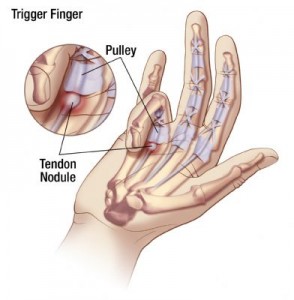 Trigger finger is a common condition that results in pain and snapping of the tendons at the base of the finger or thumb. These tendons are like pulleys that attach to the ends of the fingers to allow for finger movement. As the forearm muscle contracts, the tendons pull each finger into a fist. With trigger finger, this mechanism is not smooth and a snapping sensation can be felt, causing pain.
Trigger finger is a common condition that results in pain and snapping of the tendons at the base of the finger or thumb. These tendons are like pulleys that attach to the ends of the fingers to allow for finger movement. As the forearm muscle contracts, the tendons pull each finger into a fist. With trigger finger, this mechanism is not smooth and a snapping sensation can be felt, causing pain.
What causes trigger finger to occur?
The cause of trigger finger not clear, and this condition can appear without any particular cause. It is thought to be genetic and often occurs in one or more fingers and at different times in different locations. Trigger finger results from a difference between the size of the tendon and the entrance to the tendon sheath, usually at the base of a particular finger.
This can be the result of localized inflammation or a nodular swelling on the tendon itself. When the size difference between the tendon and the sheath is at a critical point, the tendon experiences resistance from the tendon sheath.
Initially, symptoms include pain and clicking with finger flexing, especially in the morning or with activity. As the condition worsens, the trigger finger may require active force from other fingers to straighten out or may not straighten at all due to pain. Additionally, trigger finger is thought to be caused by highly repetitive or forceful use of the thumb or finger. Changes in the tissues of the fingers can result in conditions like gout, rheumatoid arthritis, or diabetes.
What are the symptoms of trigger finger?
One of the first symptoms may be soreness at the base of the thumb or finger. A patient often complains of a painful click when they attempt to flex or extend the affected finger. Periods of inactivity can worsen the catching sensation and activity will loosen up the trigger finger, especially after rest. With severe cases, the finger becomes locked in a flexed or extended position and must be manually straightened. It is not uncommon for joint contraction or stiffening to occur.
Who gets trigger finger?
Trigger fingers occur in patients who use their fingers quite frequently. Such patients often find repetitive activities exacerbating their symptom. Trigger fingers occur more frequently in women than men, predominantly in 40 to 60 years old patients. Certain disease predispose someone to trigger finger, including diabetes, osteoarthritis, gout, and rheumatoid arthritis.
Why is it called a “trigger finger”?
The name of “trigger finger” derived from the symptom of the snapping. This ‘clicking’ or ‘snapping’ results in the affected finger remaining flexed and when there is not enough force gathered, the finger will suddenly extend, like the pulling of a trigger.
What is the treatment of trigger finger?
Often, the most effective treatment for trigger finger is an injection of steroids directly into the flexor tendon sheath. Cortisone, a steroid, decreased the swelling within the tendon and usually decreases symptoms. Over 90% of patients find some relief from a steroid injection, though in half of patients the symptoms recur. In such circumstances, we commonly offer a repeat injection or surgery, based on the patient preference.
Is surgery required to treat trigger finger?
If the condition does not resolve, a procedure to permanently release the tendon is often required. This simple outpatient procedure, called ‘trigger finger release’, is a same-day surgery that can be done under local anesthesia or a regional nerve block, without a general anesthetic. After anesthesia is given, a small incision is made in the skin of around one centimeter in size, allowing for permanent release of the tightened structures at the base of the tendon.
Recovery is quite quick, with restrictions including dressing removal at three days and full function soon after. Most people enjoy full recovery after this procedure.
What are the possible complications of a trigger finger release?
Trigger finger release surgery is very safe and usually quite effective. There are, however, some possible complications, usually residual stiffness from the chronic nature of the condition and rarely infection, which is minimized by antibiotics given at the time of the surgery. Most patients have a high success rate with the trigger finger release procedure with minimal side effects. Though the recovery varies, most patients return to work within 10-14 days, depending on the severity of the job.
If you have any questions or you think you have a trigger finger, do not hesitate to set up an appointment with Dr. Scott Ruhlman, MD or Dr. Wayne Weil, MD to further evaluate your symptoms. We make every effort to assure that you can be seen at your convenience.
Find OSS on Facebook and follow on Twitter to keep up to date on new articles and news.
